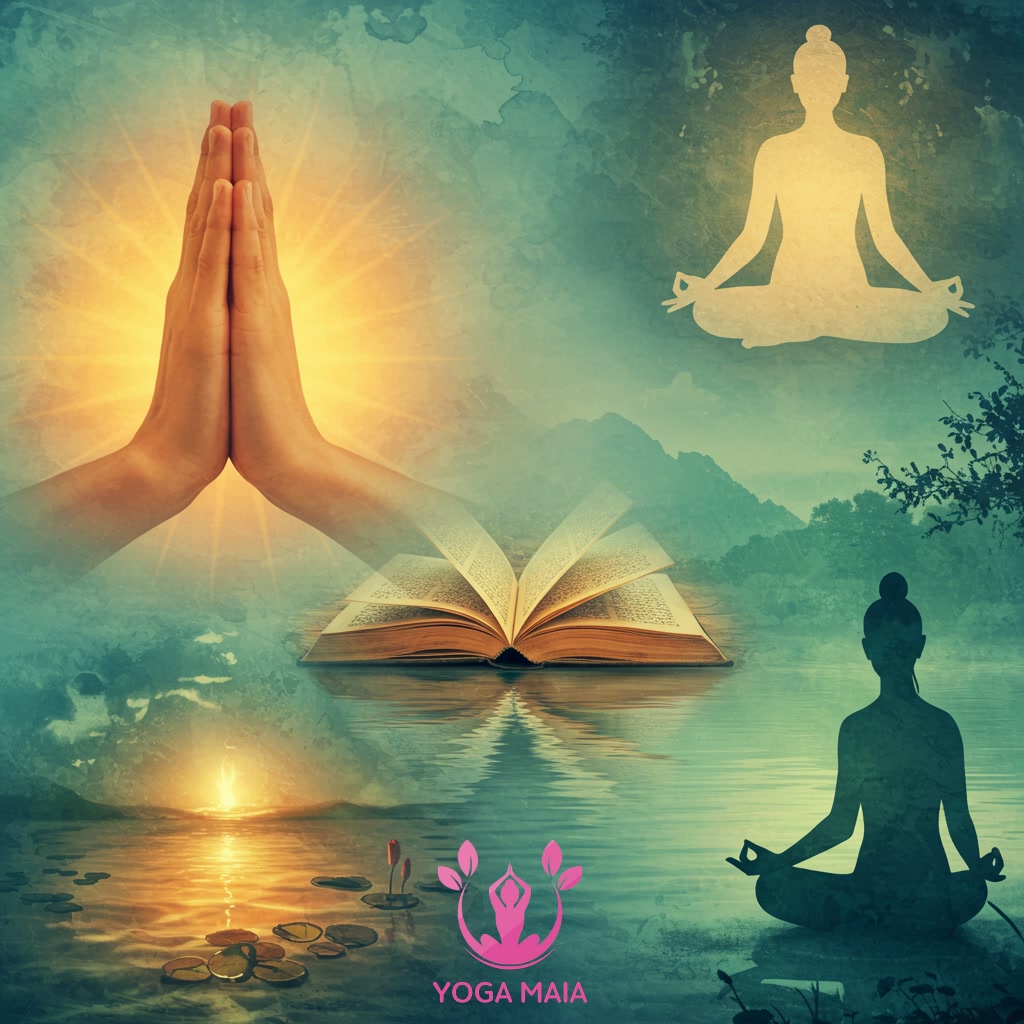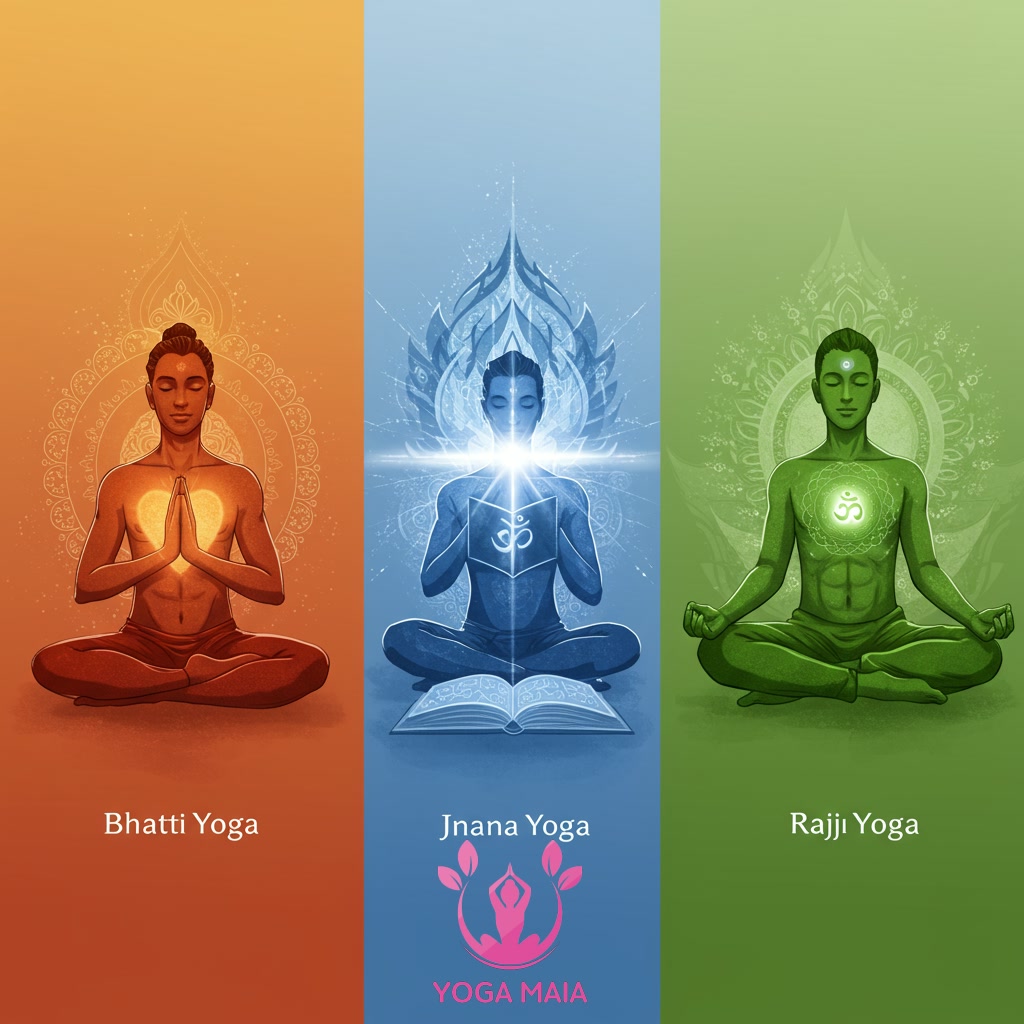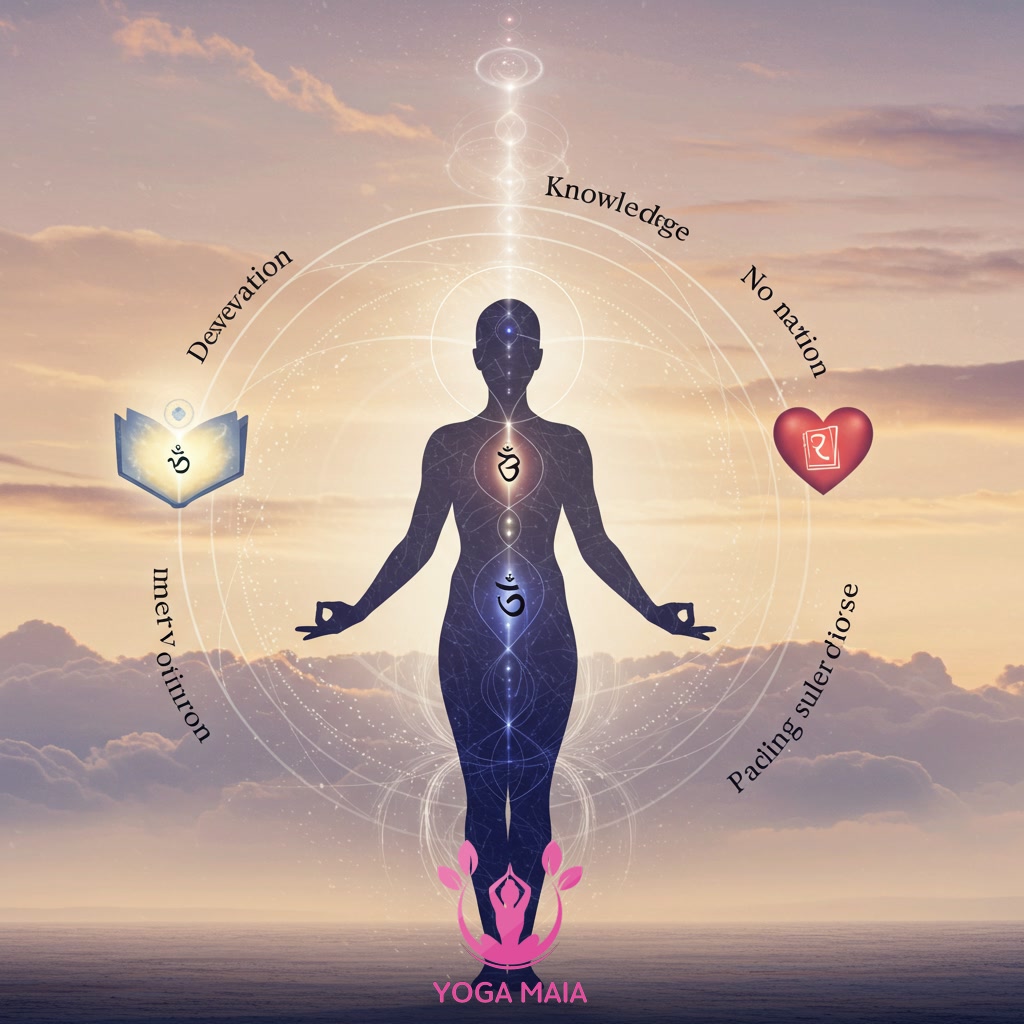Yoga Blog
Exploring the Diverse Paths of Yoga: Bhakti, Jnana, and Raja Traditions

This content explores the diverse landscape of yoga by examining three distinct paths: Bhakti, Jnana, and Raja Yoga. It highlights how each tradition offers a unique methodology for spiritual development and self-discovery. Bhakti emphasizes devotion, while Jnana focuses on intellectual wisdom, and Raja centers on meditative and physical practices. This exploration reveals the varied ways individuals can connect with the core principles of yoga.
Table of Contents
- Section 1: Introduction: The Multifaceted Nature of Yoga
- Section 2: Bhakti Yoga: The Path of Devotion and Love
- Section 3: Jnana Yoga: The Path of Knowledge and Wisdom
- Section 4: Raja Yoga: The Path of Meditation and Self-Discipline
- Section 5: Comparing and Contrasting the Paths to Enlightenment
- Section 6: Finding Your Path: Synthesis and Personal Practice
- Section 7: Conclusion: The Unified Goal of Diverse Yoga Traditions
Section 1: Introduction: The Multifaceted Nature of Yoga
Yoga is often perceived solely through the lens of physical postures, known as Asanas. However, this view captures only a small part of its rich and ancient tradition. In reality, yoga is a multifaceted discipline, offering a variety of paths and practices aimed at achieving union – with oneself, with others, or with the divine. These diverse approaches reflect the understanding that individuals possess different temperaments and inclinations, and thus require varied methodologies for spiritual growth and self-discovery. This exploration delves into some of these distinct dimensions, revealing the breadth and depth of yoga beyond its physical form and highlighting how different traditions provide unique frameworks for connecting with its core principles.
 Introduction: The Multifaceted Nature of Yoga
Introduction: The Multifaceted Nature of Yoga
Section 2: Bhakti Yoga: The Path of Devotion and Love
Moving beyond the physical postures often associated with yoga, one profound path is Bhakti Yoga, the yoga of devotion and love. This tradition centers on cultivating a deep, heartfelt connection to the divine, however one perceives it – whether as a personal deity, the universal consciousness, or the inherent goodness in all beings. Bhakti Yoga is not merely emotional worship; it is a discipline that transforms emotions into a vehicle for spiritual growth. Practices include chanting (kirtan and japa), prayer, selfless service (seva), reading sacred texts, and cultivating qualities like compassion, humility, and surrender. The goal is to purify the heart and dissolve the ego through unwavering love and dedication, leading to a state of profound union.
 Bhakti Yoga: The Path of Devotion and Love
Bhakti Yoga: The Path of Devotion and Love
Section 3: Jnana Yoga: The Path of Knowledge and Wisdom
Shifting from the devotional practices of Bhakti, we explore Jnana Yoga, the path dedicated to wisdom and knowledge. This tradition is less about ritual or physical postures and more about intellectual pursuit and self-inquiry. Practitioners engage in deep contemplation, study of scriptures, and philosophical reasoning to understand the true nature of reality and the self. Jnana Yoga seeks to dispel ignorance (avidya) through discernment (viveka) and detachment (vairagya), leading to the realization of unity consciousness. It is a rigorous path requiring sharp intellect and unwavering determination to break through illusions and attain liberation through understanding.
 Jnana Yoga: The Path of Knowledge and Wisdom
Jnana Yoga: The Path of Knowledge and Wisdom
Section 4: Raja Yoga: The Path of Meditation and Self-Discipline
Transitioning from the intellectual pursuit of Jnana Yoga, we arrive at Raja Yoga, often termed the “royal path” or the path of meditation and self-discipline. This tradition, largely based on Patanjali’s Yoga Sutras, provides a systematic methodology for controlling the fluctuations of the mind and achieving a state of inner stillness. Unlike paths emphasizing external actions or intellectual study, Raja Yoga focuses inward, utilizing techniques like asana (physical postures), pranayama (breath control), and particularly dhyana (meditation) to cultivate concentration and ultimately samadhi (union). It is a rigorous practice demanding discipline and consistent effort to master the mind and attain self-realization through direct experience.
 Raja Yoga: The Path of Meditation and Self-Discipline
Raja Yoga: The Path of Meditation and Self-Discipline
Section 5: Comparing and Contrasting the Paths to Enlightenment
Building upon the individual explorations of Bhakti, Jnana, and Raja Yoga, we can now compare and contrast their distinct approaches to the ultimate goal of spiritual realization. While all three traditions aim for liberation or enlightenment, they emphasize different faculties and practices. Bhakti Yoga follows the path of the heart, cultivating intense devotion, love, and surrender to a divine principle or chosen deity. Jnana Yoga, conversely, takes the path of the mind, seeking liberation through intellectual inquiry, self-analysis, and the discrimination between the real and the unreal. Raja Yoga, the path of practice and discipline, focuses on controlling the mind and body through techniques like meditation, breath control, and physical postures, leading to a state of mental stillness and concentration. Each path offers a unique but valid methodology, catering to different temperaments and inclinations, ultimately guiding the practitioner towards union with the higher self or universal consciousness.
 Comparing and Contrasting the Paths to Enlightenment
Comparing and Contrasting the Paths to Enlightenment
Section 6: Finding Your Path: Synthesis and Personal Practice
Having explored and compared the distinct methodologies of Bhakti, Jnana, and Raja Yoga, it becomes clear that the journey of yoga is ultimately personal. Very few practitioners adhere strictly to a single path; more commonly, individuals find their way by synthesizing elements from each tradition based on their temperament, life circumstances, and spiritual inclinations. Finding your path is not about choosing one exclusive road, but rather discerning which practices and perspectives resonate most deeply with your inner being. It involves listening to your intuition, experimenting with different approaches, and consciously weaving together devotion, knowledge, and disciplined practice in a way that fosters authentic growth and connection. This personal synthesis is the heart of sustained and meaningful yogic practice.
 Finding Your Path: Synthesis and Personal Practice
Finding Your Path: Synthesis and Personal Practice
Section 7: Conclusion: The Unified Goal of Diverse Yoga Traditions
Having explored and compared the distinct methodologies of Bhakti, Jnana, and Raja Yoga, it becomes clear that the journey of yoga is ultimately personal. Very few practitioners adhere strictly to a single path; instead, they often blend elements from different traditions, creating a practice that resonates most deeply with their individual nature and stage of development. This flexibility highlights a fundamental truth: while the paths are diverse, the ultimate goal of yoga remains unified. Whether through devotion, intellectual inquiry, or disciplined practice, the aim is consistently self-realization, union with the divine or universal consciousness, and the cultivation of inner peace and wisdom. The diverse traditions are not competing ideologies but rather different doorways leading to the same profound state of being, offering varied methods for individuals to connect with their true selves and the underlying unity of existence.
 Conclusion: The Unified Goal of Diverse Yoga Traditions
Conclusion: The Unified Goal of Diverse Yoga Traditions












